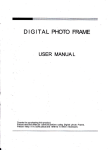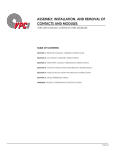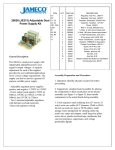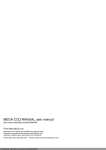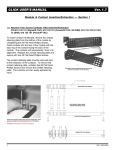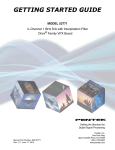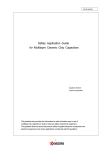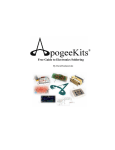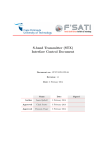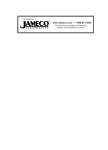Download User`s Manual(current)
Transcript
Jameco Part Number 20685 (JE2206) Function Generator Kit GENERAL DESCRIPTION The 20685 (JE2206 Function Generator Kit) is a single-board assembly incorporating the basic circuit necessary for a sine, square, and triangle wave generator, of high stability and accuracy that may be amplitude and frequency modulated. The kit is intended to be incorporated into a higher assembly of the user's own design that adds power supply, controls, and housing. • • • • • • • • • Operating from either a +12VDC or +/6VDC @ 15mA power source Frequency capability: +1 to 100KHz in 4 ranges Frequency variability: 1:100 within each range Frequency accuracy dependent upon timing capacitors and user's potentiometer (calibration by user) Sine / triangle output amplitudes variable, 0 to 6Vp-p for sine and 0V to V+/- for triangle, with 600Ω source impedance Maximum sine wave distortion: 1% 10 to 10kHz; and 3% 10 to 100kHz Linear frequency modulation capability range dependent on center frequency Linear amplitude modulation capability, range 55dB Other criteria as determined by Exar 2206 function generator IC Component Part Reference Number Description Qty. IC1 34972 1 C1, C2, C7 10882 C3 27001 C4 26956 C5 26884 C6 26833 R1 691219 R2 691340 R3, R7 690865 R4 691091 R5, R6 691032 R8 690734 R9 42981 IC Function Generator XR2206 Electrolytic Capacitor, AXIAL, 10uF @ 50V Mylar capacitor, nonpolarized, 1uF @ 100V (1K) Mylar capacitor, nonpolarized, 0.1uF @ 100V (104) Mylar capacitor, nonpolarized, 0.01uF @ 100V (0.01) Mylar capacitor, nonpolarized, 0.001uF @ 100V (102) 1/4W Resistor, 30k (orange-black-orange) 1/4W Resistor, 100k (brown-black-yellow) 1/4W Resistor, 1k (brown-black-red) 1/4W Resistor, 9.1k (white-brown-red) 1/4W Resistor, 5.1k (green-brown-red) 1/4W Resistor, 300Ω (orange-black-brown) Potentiometer, 1M (105) R10 42964 Potentiometer, 1k (102) 1 R11 35511 134341 Potentiometer, 25k (253) 22AWG black hook up wire JE2206-1 PC Board Assembly Instructions 1 1 Potentiometer, 50k Panel Mount Potentiometer, 1M Panel Mount Rotary switch, 1 layer, 2P6P SPDT mini toggle switch, MTS-102-F1 1 20706 3 1 1 1 1 1 1 2 1 2 1 1 1 1 External Components R12 255434 R13 255469 S1 101574 S2 22833 1 1 1 Recommended power supply kit if using a split power supply configuration: Jameco Part Number 20626 (JE215) Adjustable power supply kit. Assembly Preparation and Procedures: 1) Important: identify all parts on parts list before proceeding. If you are having difficulties in identifying the parts visually, suggest that you use a multimeter that can measure capacitance, resistance, voltage. Measure the components accordingly. 2) Suggestion: simulate board assembly by placing the components in their actual place on the picture assembly, then transfer the components to the actual board for soldering assembly. (see figure 1 for scanned board assembly) 3) Tools required: small soldering iron 27W to 35W; resin core solder (0.03" diameter with SN60 or SN63); small sponge (water dampened) for cleaning solder tip; small wire cutter/stripper; small long nose pliers; small screw driver; multimeter for measuring voltage, capacitance, and resistance. Soldering Tips: 1) Feed the solder to the crack between the iron tip and the solder pad next to the component lead. 2) Leaving the iron tip too long on a pad will cause the pad to life, as well as damage the component. Allow approximately 2 seconds per solder joint. 3) Using too much solder can cause the solder to bridge across traces and pads. 4) Keep iron tip clean by wiping iron across water dampened sponge -- frequently. Assembly Instructions: READ ALL INSTRUCTIONS BEFORE STARTING!!! Before assembly, determine if a split power supply or a single power supply will be used, as placement of R12 potentiometer will change (with an addition of a jumper wire across the output voltage nodes - please see figure 3 for single power supply and figure 4 for split power supply. Printed wiring board assembly 1) Start the board assembly by placing the printed circuit board to the position shown on figure 1 and figure 2 2) Insert resistors R1 through R8 into the board. Observe the color code of each resistor as you install them (color code is stated in the parts list for each resistor. If uncertain, measure the resistors with your multimeter and label them accordingly). Bend the leads at the bottom of the PCB board to contain the resistors, solder and clip excess leads. 3) Insert IC1 into board. Be sure that the notch at the end of the IC is located properly as shown for pin number 1 identification (see figure 2). 4) Insert potentiometers (adjustable resistors) R9, R10, and R11 as shown (see figure 2). Resistors R9 and R10 will require spreading of the leads to match the hole spacing on the board. R11 requires matching the adjustment knob aligned to the small rectangular shape (see figure 2). Solder leads. 5) Insert capacitors C1, C2, and C7 into the board. Note that the leads are polarized and must be placed as shown (see figure 2). Bend leads at the bottom of the PCB to contain capacitors, solder, and clip excess leads. 6) Insert capacitors C3, C4, C5, and C6. The capacitance values are marked on the components as shown in parenthesis ( see parts list) C3 = 1uF (1K); C4 = 0.1uF (104); C5 = 0.01uF (.01); C6 = 0.001uF (102) if uncertain use your multimeter to measure capacitance and label accordingly). Bend leads at the bottom of the PCB to contain capacitors, solder, and clip excess leads. Final Assembly Checkout: Do not attempt to apply power to the board until a final check has been made to verify correctness of all assembled components. Component IC1 will be damaged if placed incorrectly. Board will malfunction if capacitors C1, C2, and C7 are not properly placed on the PCB for polarity. Capacitors will be damaged after short usage. Erratic signal patterns will result from incorrect placement of resistors. Operational Considerations: 1. The schematic diagram (see schematic) shows the components supplied with the JE2206 (Jameco Part Number 20685) and noted on the same page the external components such as R13 (1M ohm) potentiometer for frequency adjustment, S1 (rotary switch) for frequency range selection), S2 (toggle switch) for wave selection, and R12 (50k) potentiometer for amplitude (connection will differ if using a single supply operation see figure 3 and split supply operation - see figure 4). Other components such as power supply and enclosure are to be supplied by the user. In addition, setting up the function generator kit will require a digital counter for frequency calibration and a general purpose oscilloscope for the calibration of sine wave output wave forms and amplitude adjust. 2. The controls: 2.1 S1 (rotary switch externalfrequency range) position 1: 1 to 100Hz range; position 2: 10Hz to 1 kHz range; position 3 - 100Hz to 10 kHz range; position 4: 1 kHz to 100 kHz range 2.2 S2 (toggle switch external) wave shape - open for triangle wave; closed for sine wave 2.3 R9 (1M ohm potentiometer) DC offset, adjust for 0VDC output-offset voltage 2.4 R10 (1k ohm potentiometer) sine wave distortion. Minimizes harmonic distortion, adjust with R11 (25k ohm potentiometer) 2.5 R11 (25k ohm potentiometer) sine wave symmetry, optimizes symmetry. Adjust with R10 (1k ohm potentiometer) 2.6 R12 (50k ohm potentiometer, panel mount external component) output amplitude, sets amplitude of sine wave or triangle wave output 2.7 R13 (1M ohm potentiometer panel mount external component) frequency, varies frequency of output signal approximately 1:100 on each range 3. Capacitors C3, C4, C5, and C6 are +/-5% mylar capacitors as 4. 5. 6. 7. 8. 9. supplied. For more accurate matching of potentiometer dialcalibration between ranges, and/or for greater stability, the user may substitute other capacitors of the same nominal capacitances. PRECAUTION: keep the lead length short for the range selector switch (S1 rotary switch) The JE2206 (function generator kit) is designed for 12V or +/-6V operation but will operate up to a maximum of 26V or +/-13V. Whatever supply is used, take care to observe correct polarity as otherwise, damage to the IC may result The sine / triangle output (terminal P) amplitude is varied by R12 (50k potentiometer panel mount). The output impedance is 600 ohms. The square wave (SYNC) outputs are derived from a grounded-emitter transistor collector connecting within the IC to terminal M. Sync-current at this terminal should not exceed that which will pull the LOW voltage higher than 0.5V above ground. Applied voltage at terminal I for the purpose of frequency modulation or sweeping should be limited to a maximum of +/-3V about the open-circuit potential of +3V. The voltage-to-frequency factor is about 0.00032/CuF Hz/V where C is the particular timing capacitor connected to S!. Linear amplitude modulation will occur for input voltages at terminal Q between +/-4V about V+/2. The phase of the output signal is reversed and its amplitude goes through zero at V+/2 Adjust the DC offset of the sine / triangle output with R9 (1M ohm potentiometer). Adjust for minimum sine-wave distortion with R10 (1k ohm potentiometer) and R11 (25k ohm potentiometer) alternately adjusted 10. SYNC output: the sync output provides a 50% duty cycle pulse output with either full swing or upper half swing of the power supply voltage depending on the choice of sync output terminals on the printed circuit board ( see figures 3 and 4 ) 11. Frequency Modulation (external sweep): frequency can be modulated or swept by applying an external control voltage to sweep terminal (terminal I). When not in use, this terminal should be left open-circuited. The open circuit voltage at this terminal is approximately 3V above the negative supply voltage and its impedance is 1000 ohms. 12. Amplitude Modulation (AM): the output amplitude varies linearly with modulation voltage applied to AM input (terminal Q). The output amplitude reaches its minimum as the AM control voltage approaches the half of the total power supply voltage. The phase of the output signal reverses as the amplitude goes through its minimum value. The total dynamic range is approximately 55dB with AM control voltage of 4V referenced to the half of the total supply voltage. When not in use, AM terminal should be left open-circuited ADJUSTMENT To adjust for minimum distortion, connect the scope probe to the triangle / sine wave output. Close S2 (toggle switch) for sine wave output and adjust the amplitude control to give non-clipping maximum swing. Then adjust R10 and R11 alternately for minimum distortion by observing the sinusoidal waveform. If a distortion meter is available you may use it as a final check on the setting of sine-shaping trimmers. The minimum distortion obtained in this manner is less than 1% from 1Hz to 10kHz and less than 3% over the entire frequency range. For further information on the operation of XR2206 IC, please refer to the datasheets found on the webpage of Jameco Part Number 20685 (function generator kit). For pin-configuration of S2 (toggle switch) refer to our website with the part number 22833, and for the S1 (rotary switch) pin configuration refer to our website with the part number 101574. Part Number 20685 (FUNCTION GENERATOR KIT) Important disclaimer: to the fullest extent permitted by applicable law, Jameco expressly disclaims the implied warranty of fitness for a particular purpose. Customer should understand that Jameco does not may any representation that products purchased will suit customer's particular purpose. Customer must rely on customer's own skill or judgment in selecting suitable products for customer. To the extent any implied warranty is applicable such warranty shall be limited to 90 days from the date of purchase. Limitation of liability: Jameco's liability shall be limited to the repair or replacement of defective products in accordance with the Jameco Limited Warranty. Jameco shall not be liable for ay incidental, special, or consequential damages for breach of any warranty, expressed or implied, directly or indirectly arising out of Jameco's sale of merchandise, including any failure to deliver any merchandise, or arising out of customer's installation or use, whether proper or improper, of the product, separately or in combination with other equipment, or from any other cause. Warranty: Jameco warrants the equipment to be free from defects for a period of 90 days from date of purchase. If found to be defective, the products will be replaced with a new unit, not repaired. No unites will be accepted past the 90 day warranty for repair or replacement. There is not charge for any replacement. Equipment or parts which have been subject to abuse, misuse, accident, alteration, neglect, and/or unauthorized repair are not covered by the warranty. Seller shall have the right to final determination as to existence and cause of defect. R Q (AM INPUT) F (output) Schematic Diagram with External Rotary Switch (S1) for Frequency Range Selection, SPDT switch (S2) for TRI/SINE Wave selection, and 1M ohm Potentiometer (R13) for FREQUENCY. Not Shown is 50k potentiometer (R12) for AMP ADJUST – connection of pot to PCB depends on single supply operation (see figure 3) or split supply (see figure 4) A (V-) R7 (1k) B (GRND) R1 (30k) - R9 (1M POT) C1 (10uF @ 50V) + DC OFFSET R2 (100k) 1 C2 (10uF @ 50V) + SCHEMATIC 16 R11 (25k POT) 2 15 R10 (1k POT) 3 S2 TRI/SINE WAVE O 14 R8 (300 ohms) C (V+) 5 IC 1 XR2206 6 N 13 12 11 + 7 10 8 9 M SYNC OUTPUT (FULL SWING) R6 (5.1k) 4 C7 (10uF @ 50V) D E 2 H (S1) 3 4 F G C3 (1uF) R4 (9.1k) 1 R3 (1k) NC C4 (0.1uF) NC R5 (5.1k) C5 (0.01uF) C6 (0.001uF) R13 (1M) FREQUENCY RANGE I (Sweep Input) J FREQUENCY K (V-) L SYNC OUTPUT (HALF-SWING) Scanned Picture of Printed Circuit Board Figure 1 Notes on Capacitor Polarity and IC pin identification Figure 2 Take note of capacitor polarity; if aluminum electrolytic capacitor has a polarity indicator, arrow will point to which side of the capacitor is negative or positive. Make note of integrated circuit before soldering into board, notch on IC should be aligned to the notch indicator on the PCB board. R10 potentiometer making note of pin layout. You may have to spread pins to match hole spacing. Take note of capacitor polarity; if aluminum electrolytic capacitor has a polarity indicator, arrow will point to which side of the capacitor is negative or positive. Adjustment knob of R11 should be aligned to small rectangular shape. R9 potentiometer making note of pin layout. You may have to spread pins to match hole spacing. Take note of capacitor polarity; if aluminum electrolytic capacitor has a polarity indicator, arrow will point to which side of the capacitor is negative or positive. Frequency Sweep Input SYNC OUTPUT (HALF SWING) SYNC OUTPUT (FULL SWING) 1M OHM (R13) POTENTIOMETER FREQ ADJUST Connections for Single Supply Operation Figure 3 Rotary Switch (S1) for Frequency Range Selection +12V GROUND Solder wire across node A and node above A S2 Switch for TRI / SINE WAVE Signal Output Amplitude Modulation Input 50k Potentiometer (R12) AMP ADJUST Connections for Split Power Supply Operation SYNC OUT (HALF SWING) Figure 4 R13 (1M ohm) POT FREQ S1 (rotary switch) Frequency Range SYNC OUT (FULL SWING) V+ (+6V) V- (-6V) S2 TRI / SINE WAVE OUTPUT AM INPUT R12 (50k ohm) Pot AMPLITUDE










